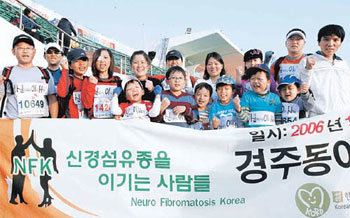Neurofibromatosis Awareness Runners

An hour and 35 minutes had past since the starting gun fired.
It was in the 2006 Dong-A Ilbo Gyeongju Open Marathon, when most of the runners for the 10km course, as well as many of those running in the half-course, were finishing their races. A little child was passing the finish line, almost dragging his feet. Roh Ju-hyun, six years old, just competed his 10km race with his father Roh Jae-uk (33) and mother Seo Se-yeon (34).
Although totally exhausted, his face turned bright soon. It was fun to run with mom and dad. The right side of Ju-hyuns face is distinctively swelled up since he has a neurofibromatosis, a rare and obstinate disease. The disease is a formidable one that causes tumors to grow along the neural system and might spread them all over ones body. It might develop complications such as brain tumor, scoliosis, dislocation and facial malformation, but there is no medicine to treat it yet. In Korea, it is known that more than 20,000 are suffering from this disease.
Thirteen runners from Neurofibromatosis Korea, a club consisting of patients and their families, participated in this marathon and all of them completed their 10km races.
Seo, Ju-hyuns mother said, Koreans are informed too little about neurofibromatosis. People tend to avoid patients after they see their particular appearances, whispering behind them that it might be infections. I want to let people know that it isnt. It occurs either by mutation or heredity.
They figured out that joining a marathon together would be a good idea to spread this information. Starting from the Gyeongju Open Marathon last year, they have thus far taken part in three marathons and completed all of them. Connected with the same type of suffering, they got closer to each other while running and building themselves up together. They were also able to diffuse more information of neurofibromatosis throughout the country and society.
Seo said, Ju-hyuns friends in kindergarten used to avoid him at first. But as they came to know that hes not different from them except that hes little more ill, they now get along pretty well. I hope that our whole society can develop better relationships with neurofibromatosis patients.







